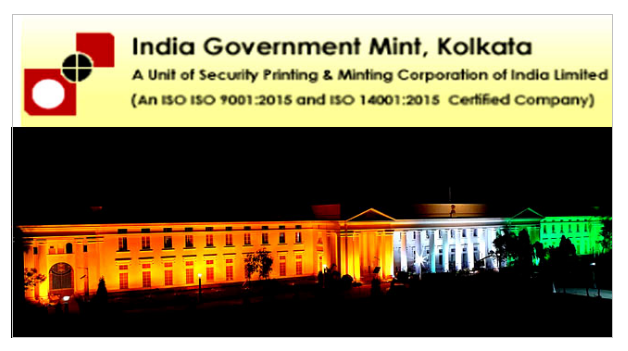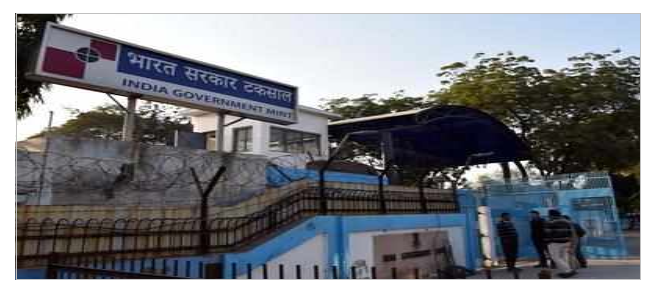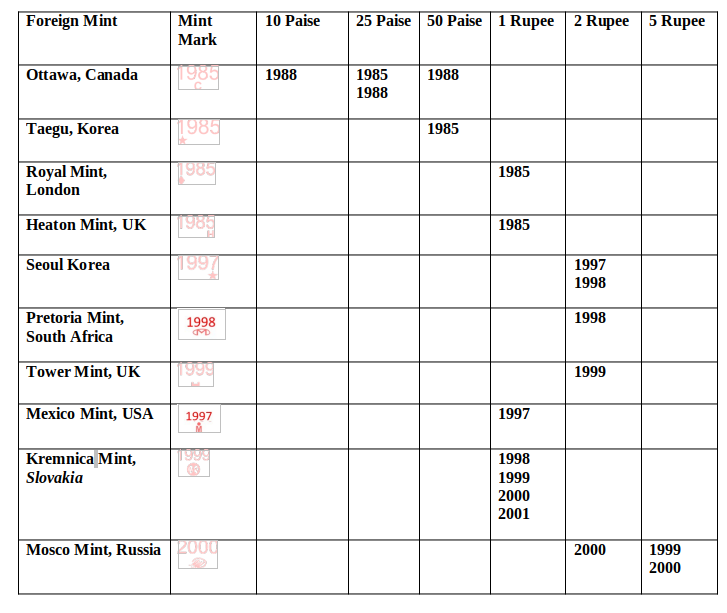Minting of Coins in India:
According to the Coinage Act of 1906 amended from time to time, the Government of India has the sole right to design and mint Republic India coins and currency. The coins are issued for circulation only through the Reserve Bank in terms of the RBI Act.
Did You Know:
With the end of the Mughal Sultanate in 1858, all private mints except those in Mumbai, Kolkata and Hyderabad were abolished.

The management, control, maintenance and operations of the erstwhile 9 production units across India were transferred to Security Printing and Minting Corporation of India Limited or SPMCIL from 10th February 2006 which is a wholly owned Mini Ratna company of the Government of India incorporated on 13th January 2006. SPMCIL is not only engaged in the minting of coins but also manufactures and produces banknotes, non-judicial stamp papers, travel documents like passports and visas, refining of gold and silver and many other products. It is under the jurisdiction of the Ministry of Finance of the Government of India. SPMCIL broadly operates through 4 production verticals namely:
- Paper Mill in Hoshangabad, Madhya Pradesh for production of papers for banknotes, non-judicial stamp papers etc.
- Currency Printing Presses at Nasik and Dewas for printing banknotes..
- Security Printing Presses at Nasik and Hyderabad for printing passports, non-judicial stamp papers etc etc.
- Mints at Mumbai, Kolkata, Hyderabad and Noida for mintage of Republic India coins, medallions and bullions.
Point To Note:
The Bhartiya Reserve Banknote Mudran Private Limited, a Wholly Owned Subsidiary of the RBI owns two presses at Mysore, Karnataka and Salboni, West Bengal which also print banknotes.
Did You Know:
SPMCIL has been minting coins and notes of other countries as well. Some of these nations include Sri Lanka, Nepal, Bhutan etc. etc.
Now let’s take a glance at the 4 mints of India.

The Kolkata mint was established in 1760 with the mint name Murshidabad. Later, the foundation for a new mint was laid at Strand Road Kolkata which started production in 1829. The foundation of The existing mint at Alipore Kolkata was laid in 1942 however its construction was interrupted by the Second World War and it was finally inaugurated in 1952. The coins minted by the Kolkata Mint are identified by the absence of any mint mark

The Mumbai mint is the oldest mint of India. The first Mumbai mint rupee was coined in the year 1672. The existing Mumbai mint was constructed between 1824 to 1830. In 1919, a gold refinery and later in 1929 a silver refinery were established in the Mumbai mint. The mint mark on the coins minted in the Mumbai mint is a diamond which is placed below the year of minting. However for proof-sets, the mint mark was B and now an M. The alphabet B was used as before 1995 the name of the city was Bombay after which it was known as Mumbai leading to the change from B to M.
Did you know: A mint mark of 'U' was used only once by the Mumbai mint in the year 1989 for pandit Jawaharlal Nehru’s UNC Sets coins.

Now let’s take a look at the Hyderabad mint which was initially established in 1803 to serve the Nizam of Hyderabad. In 1948 the state of Hyderabad came under the control of the Government of India and in 1950 the mint was taken over by the Government of India. In 1997 it was shifted to its present location in Cherlapally in Secunderabad. The mint marks used by the Hyderabad mint (all placed below the year of minting) are as follows:
- The vertically split diamond from 1953-61
- The dot in diamond from 1961-68
- The five-pointed star mark from 1965 onwards
Yes, indeed two Hyderabad mint marks were used simultaneously in the year 1961 and from 1965-68. In 1961 the vertically split diamond and dot in diamond were used simultaneously and from 1965-68 the dot in diamond and five-pointed star mint mark were used simultaneously.

Now let’s talk about the only mint established post-independence era i.e. the Noida Mint . In order to fill the gap between the demand and supply of coins in the country the government of India decided in 1984 to establish a new mint in Noida. This mint started regular production from 1st July 1988. The mint mark used by the Noida mint is a round dot placed below the year of minting.

Point to note:
All mint marks of the Indian Mints including the five pointed star mark of Hyderabad mint are placed below and perfectly in between the 4 numerals of the year of minting.
Did You Know: many Republic India Coins have been minted by foreign mints as well details are as under:
Indian Coins minted by Foreign mint
Due to a sudden and temporary increase in demand, foreign mints were used for minting of coins from 1985 - 2001. These coins were sourced from 10 different foreign mints.
The 10 Paise Stainless Steel Coin was minted by the Royal Mint of Ottawa in 1988. The Royal Mint of Ottawa is identified by its mint mark “C” which is as usual below the year of minting. Remember not to confuse this C for the Calcutta mint or as we now call it the Kolkata mint which doesn’t have any mint mark.
The 25 Paise Copper Nickel Coin was also minted by the Royal Mint of Ottawa in 1985 and 25 Paise Stainless Steel Coin was also minted by the Royal mint of Ottawa in 1988.
The 50 Paise Copper Nickel coins was minted by the Taegu Mint in Korea in 1985 and 50 Paise Stainless Steel coins by the Royal Mint of Ottawa in 1988. We have already described the mint mark of Ottawa. The Taegu mint is represented by a Star similar to that of Hyderabad which is placed below the first numeral of the year of minting.
The 1 Rupee Copper Nickel Coin was minted by the Heaton and London Mints in 1985. Moreover the 1 Rupee Stainless Steel coin was minted by the Mexico Mint in 1997 and Slovakia Mint from 1998-2001. The mint mark of the Heaton Mint is an “H” inscribed below the last numeral of the year of minting. The mint mark of the Royal mint of London is a diamond below the first numeral of the year. The mint mark of the mint of Mexico mint is an “M with a small O above it” which is placed below the year of minting. The mint mark of the Slovakia mint is “MK” which is inside a circle just below the year of minting.
The 2 Rupees Copper Nickel coins were minted by the Seoul mint in 1997 and 1998, the Pretoria mint of South Africa in 1998, the tower mint of UK in 1999 and Moscow mint of Russia in 2000. The Seoul mint is represented by a Star similar to that of Hyderabad which is placed below the last numeral of the year of minting. The mint mark of the tower mint of UK is a U below the year of minting which resembles the shape of twin towers. The Pretoria mint of South Africa is represented by M in an oval below the year of minting. The M is extremely flat and resembles a horizontal dot. and The Moscow mint of Russia is represented by MMD in an oval below the year of minting.
The 5 Rupees Copper Nickel coin was minted by the Moscow mint of Russia in 1999 and 2000. As described previously the mint mark of the Moscow mint is MMD in an oval below the year of minting. This mint mark resembles a signature.
In all 14 varieties (Denomination & Mint) and 19 combinations of Republic India Coins were minted across 10 different foreign mints from 1985-2001. As the minting of coins has reduced drastically, it can be safely assumed that no more republic India coins will be required to be minted by any foreign mints. Hence, these souvenirs of Indian History will be a highly sought-after collectible going forward. Therefore, you must target to have a complete set of Republic India coins minted in Foreign Mint in your collection at the earliest.
Indian Coins minted by Foreign mint

